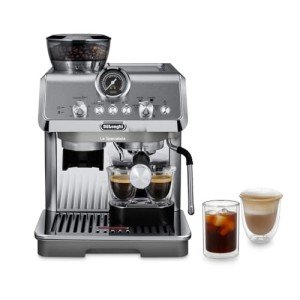How To Explain Italian Espresso Machines To A Five-Year-Old
Heat Exchange Espresso Machines: A Comprehensive Guide
Espresso machines have evolved substantially over the years, catering to the needs of home baristas and coffee experts alike. Among these machines, heat exchange espresso machines have gotten popularity due to their ability to provide consistent performance and remarkable brew quality. In this article, we will explore the functions, benefits, and essential functions of heat exchange espresso machines, supplying a detailed understanding for both prospective buyers and coffee lovers.
Understanding Heat Exchange Technology
Heat exchange espresso machines run on a distinct principle that permits simultaneous water heating for brewing and steaming. They are geared up with a single boiler that utilizes a heat exchanger system. This function is considerable as it makes it possible for users to brew espresso while steaming milk simultaneously, promoting performance in the coffee-making procedure.
How Does a Heat Exchange Espresso Machine Work?
The process starts with the machine's water inlet filling the boiler. As the water warms up, it turns to steam. The innovative heat exchanger uses hot steam to heat additional water in a separate passage developed particularly for the brew group. This suggests that water can reach the perfect brewing temperature level without awaiting the boiler to change. The key actions consist of:
- Water Fill: Water is drawn into the boiler.
- Heating Process: The boiler heats up as water is transformed into steam.
- Heat Exchange: Steam warms water in the heat exchanger tube.
- Developing: Water from the heat exchanger is pushed through coffee premises, drawing out the tastes needed for a rich espresso.
This procedure permits quick temperature level modifications and improved coffee extraction.
Advantages of Heat Exchange Espresso Machines
Heat exchange espresso machines offer several benefits, particularly for those seeking to optimize their coffee experience. Here are some essential advantages:
- Simultaneous Brewing and Steaming: Users can brew espresso while steaming milk, making it perfect for busy cafes and home baristas who value effectiveness.
- Temperature level Stability: The boiler's steam pressure helps keep a steady temperature level, which is crucial for consistent espresso extraction.
- Flexibility: The style permits fast changing in between developing and steaming, making it much easier to develop various coffee drinks, from lattes to cappuccinos.
- User-friendly: Models typically come with available controls, making it feasible for both newbies and experienced baristas to produce quality drinks.
- Professional Quality: Heat exchange machines are frequently used in commercial settings, offering users with high-quality brewing performance in the house.
Key Features to Look for in Heat Exchange Espresso Machines
When considering the purchase of a heat exchange espresso machine, there are several features that one need to consider:
- Build Quality: Look for machines made from resilient products, such as stainless steel or brass, ensuring longevity.
- Boiler Size: A bigger boiler will hold more water and sustain higher output with time.
- PID Temperature Control: This feature helps preserve constant brew temperatures, which can improve the coffee-making process.
- Group Head Design: Machines with a saturated or semi-saturated group head provide much better temperature level stability.
- Ease of Use: User-friendly interfaces and user-friendly controls enhance the total experience for baristas at all skill levels.
- Steam Wand Quality: An excellent steam wand with proper insulation and versatility enables much better texturing of milk.
- Water Reservoir Size: Depending on your requirements, think about how often you want to fill up the water tank.
Contrast of Popular Heat Exchange Espresso Machines
To much better understand the options offered in the market, listed below is a contrast table of some popular heat exchange espresso machines:
Machine Model
Boiler Size
PID Control
Cost Range
User Ratings
Profitec Pro 700
2.0 L
Yes
₤ 2,000-₤ 2,500
9.5/ 10
Rocket Espresso R58
1.8 L
Yes
₤ 2,400-₤ 2,800
9.4/ 10
Elekta Bianca
1.8 L
Yes
₤ 2,500-₤ 3,000
9.6/ 10
La Spaziale S1 Vivaldi II
1.5 L
Yes
₤ 1,800-₤ 2,200
9.2/ 10
Bezzera Magica
1.2 L
No
₤ 1,600-₤ 1,800
9.0/ 10
Frequently Asked Questions About Heat Exchange Espresso Machines
What is the main distinction between a heat exchange and a dual boiler espresso machine?
While both types can brew espresso and steam milk at the exact same time, dual boiler machines have separate boilers for brewing and steaming. In contrast, heat exchange machines use a single boiler and a heat exchanger to accomplish the exact same function.
Are heat exchange machines ideal for newbies?
Yes! Many heat exchange machines are designed with user-friendly features, making them available for beginners. With Best Espresso Machines and practice, users can rapidly produce quality espresso.
What kind of upkeep do heat exchange espresso machines require?
Regular maintenance consists of descaling, cleaning up the boiler, inspecting seals and gaskets, and keeping the group head clean. Regular maintenance makes sure longevity and consistent performance.
Can I use a heat exchange machine for different types of coffee beverages?
Definitely! Heat exchange machines allow users to create a range of coffee beverages, consisting of espresso, lattes, cappuccinos, and more.
Heat exchange espresso machines represent a blend of innovation and custom, offering coffee lovers with the tools required for crafting the ideal cup. Their ability to all at once brew and steam, integrated with exact temperature level control, makes them an engaging choice for both home baristas and experts. With the best knowledge on functions and upkeep, users can unlock a world of splendid coffee experiences, ensuring that each sip is as wonderful as the last.
